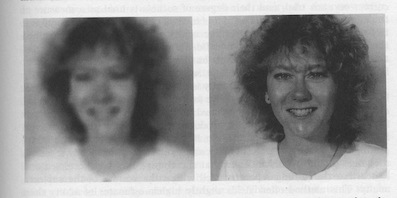The ability to see fine details in a visual stimulus, typically measured by the number of degrees of visual arc subtended by object that can just be discriminated or by the width of the object itself. Visual acuity is reported to developsubstantially during the first months and years of life. This finding is basedon results obtained by Fantz (1963) using apreferential looking design. Fantz simultaneously presented two stimuli to theinfant, a square with black and white stripes of varying width in combinationwith a gray square (see Fig.1 below). In case the infants discriminate between the two squares,that is, they preferentially look at one of the two, usually the more complexone, this is taken as evidence that they perceive the difference. In case theydo not discriminate the two patterns, this is interpreted as that the infantsperceive both squares as equally gray. The same procedure iss used to assessinfants’ perception of contrast. The typical finding is that infants thatnewborns are constrained in their visual acuity and contrast sensitivity at thelevel of around 5 % of adults (see Fig. 2 below). Their visual perception undergoes then asubstantial development during the next few months making their visualperception being close to adults around their first birthday.

